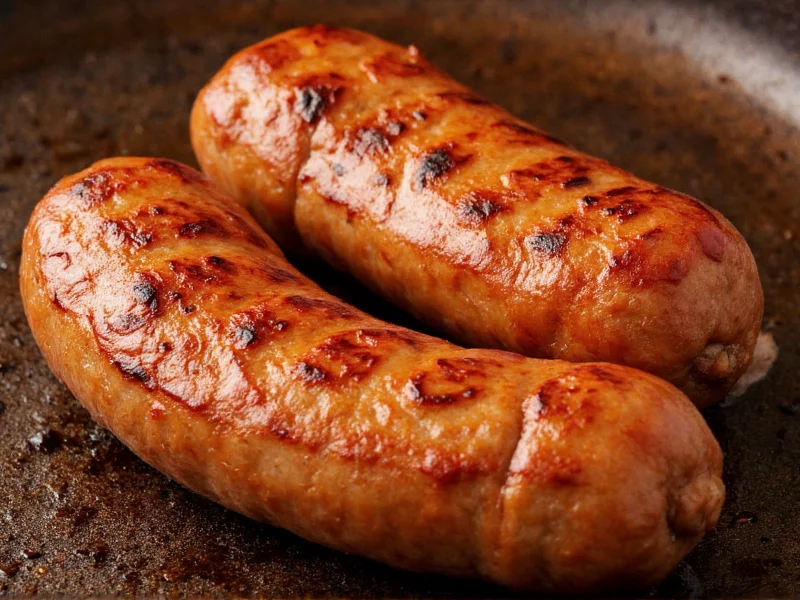Understanding proper sausage cooking temperatures is essential for both food safety and culinary success. Many home cooks rely on visual cues like color or texture to determine doneness, but these methods are unreliable and potentially dangerous. The only accurate way to verify sausage is fully cooked is by using a food thermometer to check the internal temperature.
Why Temperature Matters More Than Appearance
Unlike whole cuts of meat where surface cooking kills pathogens, sausages present unique food safety challenges. The grinding process distributes potential bacteria throughout the product, making thorough internal cooking critical. The USDA Food Safety and Inspection Service emphasizes that color alone cannot indicate doneness - pork sausages may remain slightly pink even when properly cooked, while poultry sausages might appear done before reaching safe temperatures.
Sausage Temperature Guidelines by Type
| Sausage Type | Safe Internal Temperature | Special Considerations |
|---|---|---|
| Pork, Beef, Lamb Sausages | 160°F (71°C) | Hold temperature for at least 15 seconds |
| Poultry Sausages (Chicken, Turkey) | 165°F (74°C) | More susceptible to salmonella |
| Pre-cooked Sausages (Heating Only) | 140°F (60°C) | Verify manufacturer's instructions |
Proper Thermometer Technique for Sausage
Using a food thermometer correctly makes all the difference in accurate temperature readings. For best results when checking sausage done temp:
- Insert the thermometer probe into the thickest part of the sausage, avoiding contact with the cooking surface
- For links, insert sideways through the center rather than from end to end
- Check multiple sausages in a batch as cooking can be uneven
- Allow 10-15 seconds for digital thermometers to stabilize
- Calibrate your thermometer regularly using ice water (32°F/0°C) or boiling water (212°F/100°C)
Common Temperature Mistakes to Avoid
Many home cooks make critical errors when determining sausage doneness. The most dangerous misconception is that sausage must be gray throughout to be safe. In reality, properly cooked pork sausage often retains a slight pink hue due to curing agents or myoglobin. Other common mistakes include:
- Testing temperature too early in the cooking process
- Not allowing sausages to rest for 3-5 minutes after cooking (temperature continues to rise 5-10 degrees)
- Using visual cues like clear juices as the sole indicator of doneness
- Not cleaning the thermometer probe between readings
Food Safety Implications of Undercooked Sausage
Consuming sausage cooked below recommended temperatures carries significant health risks. Undercooked pork products may contain Trichinella spiralis, while poultry sausages can harbor salmonella or campylobacter. These pathogens cause foodborne illnesses with symptoms including abdominal pain, diarrhea, fever, and vomiting. For vulnerable populations like children, elderly individuals, and those with compromised immune systems, these illnesses can become severe or even life-threatening.
Practical Cooking Tips for Perfect Sausage
Achieving the ideal sausage done temp requires proper cooking technique. For stovetop cooking, start with medium-low heat to render fat gradually without burning the exterior. When grilling, use indirect heat initially to cook through before finishing over direct flame for char. Regardless of method, always let sausages rest for several minutes after reaching target temperature - this allows juices to redistribute and the internal temperature to stabilize.
Special Considerations for Different Sausage Styles
Traditional fresh sausages require the full temperature treatment outlined above. However, certain specialty sausages have different requirements:
- Dry-cured sausages (like salami): These are safe to eat without cooking as they undergo fermentation and drying processes
- Smoked sausages: Some are fully cooked during production and only need reheating to 140°F
- Breakfast sausages: Typically follow standard pork sausage temperature guidelines
When in doubt about a specific product, always consult the manufacturer's instructions or assume standard cooking temperatures apply.
Essential Tools for Accurate Temperature Monitoring
Investing in a quality instant-read thermometer significantly improves your ability to determine accurate sausage cooking temperature. Look for models with:
- Fast response time (3-5 seconds)
- Accuracy within ±1°F
- Thin probe for minimal damage to sausages
- Backlit display for visibility
While traditional dial thermometers work, digital models provide more precise readings essential for hitting the exact sausage done temp without overcooking.











 浙公网安备
33010002000092号
浙公网安备
33010002000092号 浙B2-20120091-4
浙B2-20120091-4